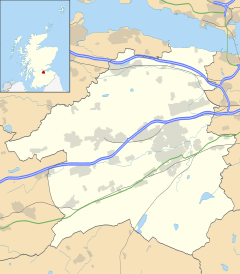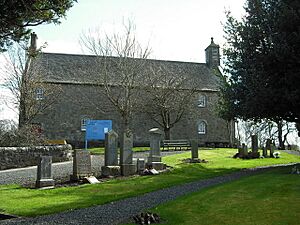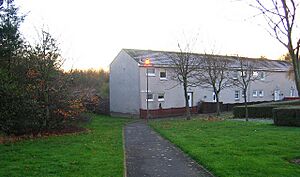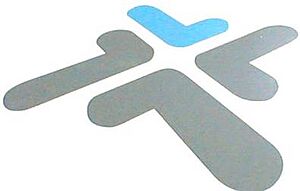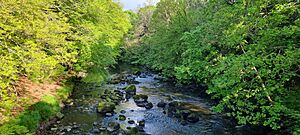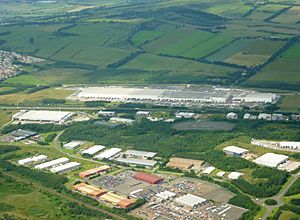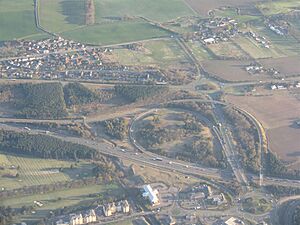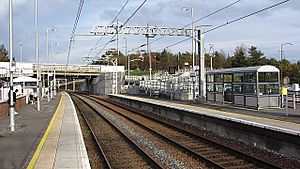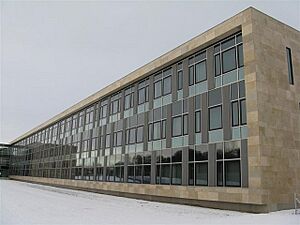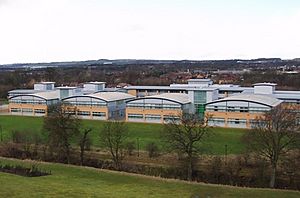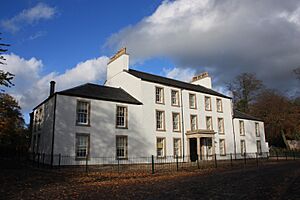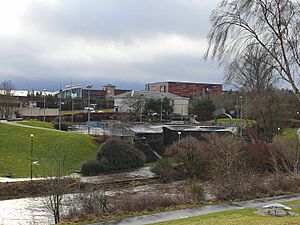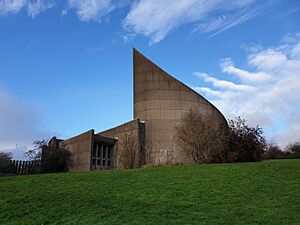Livingston, West Lothian facts for kids
Quick facts for kids Livingston
|
|
|---|---|
| New town and administrative centre | |
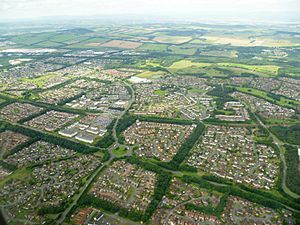 Aerial view of the north west of the town |
|
| Population | 56,840 (2020) |
| Language | English, Scots |
| OS grid reference | NT054690 |
| • Edinburgh | 14 mi (23 km) ENE |
| • London | 321 mi (517 km) SSE |
| Council area | |
| Lieutenancy area | |
| Country | Scotland |
| Sovereign state | United Kingdom |
| Post town | LIVINGSTON |
| Postcode district | EH53, EH54 |
| Dialling code | 01506 |
| Police | Lothian and Borders |
| Fire | Lothian and Borders |
| Ambulance | Scottish |
| EU Parliament | Scotland |
| UK Parliament |
|
| Scottish Parliament |
|
Livingston (also known as Leivinstoun in Scots and Baile Dhunlèibhe in Gaelic) is the biggest town in West Lothian, Scotland. It was officially created in 1962, making it the fourth "new town" built in Scotland after World War II. The town got its name from an older village that became part of it. It was built along the River Almond and is about 15 miles (25 km) west of Edinburgh and 30 miles (50 km) east of Glasgow. Nearby towns include Broxburn and Bathgate.
Livingston was formed by joining several small villages like Livingston Village, Bellsquarry, and Livingston Station (now part of Deans). Today, it has many different neighborhoods, including Craigshill, Howden, Ladywell, Knightsridge, Deans, Dedridge, Murieston, Almondvale, Eliburn, Kirkton, and Adambrae. The town also has large areas for businesses and factories, such as Houston Industrial Estate and Kirkton Campus. In 2011, Livingston's population was 56,269, making it the second-largest settlement in the Lothians area, after Edinburgh.
Contents
- Discover Livingston's Past
- Exploring Livingston's Landscape
- Livingston's Economy and Jobs
- Livingston Town Centre and Shopping
- Getting Around Livingston
- Media and News in Livingston
- How Livingston is Governed
- Education and Libraries in Livingston
- Culture and Fun in Livingston
- Sports in Livingston
- Religion in Livingston
- Famous People from Livingston
- Livingston's Twin Towns
- See also
Discover Livingston's Past
Before Livingston Became a New Town
Livingston was first mentioned in the early 1100s as Villa Levingi, meaning "Leving's town." In 1128, King David I gave control of the church in Livingston to Holyrood Abbey. A man named Thurstan, son of Leving, built a strong tower called Livingston Peel, but it no longer exists. The area around it grew and became known as Levingstoun, then Layingston, and finally Livingston.
For a long time, the area around Livingston was important for shale oil mining. This was the world's first "oil boom" in West Lothian. By 1870, over 3 million tons of shale were mined each year. This industry slowed down when liquid oil was found elsewhere, but shale mining only completely stopped in 1962. The large piles of waste from mining, called "bings," have mostly been flattened.
By 1898, the main Livingston village had houses, a mill, churches, a school, and an inn. The oldest church, Livingston Old Kirk, was built in 1732. A nearby inn, built in 1760, is said to have hosted the famous poet Robert Burns. The Livingston Mill was also built around 1770. About a mile north of the village, there was a smaller settlement called Livingston Station, which is now part of Deans. This settlement grew around a railway station built in 1849. Both Livingston Village and Livingston Station later became part of the new town.
How Livingston Became a New Town
In 1962, Livingston was chosen to be a "New Town" to help with overcrowding in Glasgow. It was the fourth of five new towns in Scotland. Three villages – Livingston Village, Livingston Station, and Bellsquarry – were included in the new town's plans. The first plan in 1962 aimed to build homes for up to 100,000 people, along with new areas for businesses and offices. Many of the first houses were built in factories.
To build and manage Livingston, a special organization called the Livingston Development Corporation (LDC) was created. Construction of homes began in 1962 in Deans. The first major development was in Craigshill, with people moving into new homes there in April 1966. Other areas like Howden, Ladywell, and Knightsridge were built in the late 1960s, followed by Dedridge and more of Deans in the 1970s. Important early buildings included Riverside Primary School (1966), Livingston Fire Station (1967), the first pub (The Tower in Craigshill, 1968), Craigshill secondary school (1969), and the main shopping center, "The Centre" (1977).
By 1971, Livingston's population had grown to 14,000. In 1979, the famous Livingston UFO Incident happened, where a man named Robert Taylor reported seeing a UFO on Dechmont Law. This event was investigated by the police.
In the 1980s, new railway stations were built: Livingston South in 1984 and Livingston North in 1986. These replaced older stations that had closed. In 1995, Livingston got its own professional football team, Livingston F.C., which moved from Edinburgh.
The LDC managed Livingston until 1997, when the town was handed over to the West Lothian Council. Building new homes continues today with private companies and housing groups. In 2021, Livingston tried to become a city for the Queen's Platinum Jubilee, but it wasn't chosen. However, 2022 marked its 60th anniversary as a town!
Exploring Livingston's Landscape
Livingston is the eighth-largest settlement and the third-largest town in Scotland. It's about 30 miles (48 km) from Glasgow and 15 miles (24 km) from Edinburgh. The River Almond flows right through the town center.
Livingston has many different areas. Outer areas include Wester Dechmont, Deans, Kirkton, and Houston to the north. To the east is Craigshill, to the south are Bellsquarry and Murieston, and to the east of the town are Adambrae and Kirkton Campus.
Central areas include Almondvale, Livingston Village, Eliburn, Howden, Ladywell, Knightsridge, and Dedridge. Ladywell is named after an old well dedicated to Mary, which was said to be used by Scottish Kings.
Livingston's ground is mostly made of till from ancient glaciers, including clay, sand, silt, and gravel along the Almond river. Some parts also have limestone rocks, which were mined for shale oil in the past. The town also has areas of sandstone that were used for quarries, like Dedridge quarry, which is now a park. Bellsquarry is named after an old limestone quarry and its owner, Mr. Bell.
Before Livingston became a new town, the area was mostly farmland. Now, it's an urban area, but it still has many forested paths, public parks, and open spaces. Some of these green areas include Livingston Old Wood in Eliburn, the Wilderness in Adambrae, and Bellsquarry Wood.
 |
Falkirk (19km), Bathgate (8km) | Linlithgow (10km) | Broxburn (5km) |  |
| Glasgow (46km), Airdrie (27km) | Edinburgh (23km) | |||
| West Calder (6km), Shotts (19km) Lanark (31km) | The Borders, Harburn | East Calder (3km) |
Livingston's Economy and Jobs
In the past, Livingston was known for oil shale mining, and you can still see signs of this history in the landscape. When Livingston became a new town in the 1960s, it attracted new light industries, especially high-tech and pharmaceutical companies. Livingston was a big part of Scotland's "Silicon Glen," with factories in business parks like Houston Industrial Estate and Kirkton Campus.
Even though some big companies have left, many multi-national companies still have factories here. For example, Wyman Gordon makes aircraft parts, and Mitsubishi Electric produces air conditioning units. Other companies include Paterson Arran (a food manufacturer) and DS Smith (a box production plant).
Kirkton Campus was developed as Scotland's first technology science park. Today, it's home to Sky UK, one of Livingston's largest private employers, with offices and a big contact center. Other companies at Kirkton Campus include Merck (a pharmaceutical company) and Edinburgh Instruments (which makes scientific equipment).
Other major employers in Livingston include Tesco (with its distribution center for Scotland and Northern Ireland), Schuh (whose head office is here), and Shin-Etsu Europe (which makes semiconductors). The Witherby Publishing Group, one of the oldest publishers in the UK, has its offices and warehouse in Livingston. Valneva SE is a biotech company that makes vaccines, including one for COVID-19.
The Brucefield Industrial Estate has companies like Diet Chef (food) and Snag Tights (textiles). Alba Business Park is home to Glenmorangie (whisky distillers), Quintiles IMS (healthcare data), and Össur (a company that makes prosthetics).
Livingston Town Centre and Shopping
Livingston's town center is on the southern edge of the Almond Valley. It's designed with a ring road and is different from many older town centers. Howden Park, with its arts center and the historic Howden House, is just north of the town center. The southwestern part of the town center has many retail parks. Livingston also has many offices, hotels, a swimming pool, and restaurants. The Almondvale Football Stadium and West Lothian College are at the northwestern edge of the town center.
The Livingston Civic Centre, opened in 2009, is the main building for local government. It houses the West Lothian Council, local courts, and police services.
Shopping in Livingston
Livingston has three main shopping centers and several retail parks. The biggest shopping centers are 'The Centre' (which has over 1 million square feet of shops) and Livingston Designer Outlet (the largest outlet mall in Scotland). Together, these form the biggest indoor shopping area in Scotland.
The first part of The Centre opened in 1977. It has been expanded over the years and now has about 155 shops and places to eat. The Livingston Designer Outlet opened in 2000 and includes a VUE cinema, a food court, and about 70 outlet shops. There's also a large Asda supermarket, which is the biggest Asda store in Scotland.
Other supermarkets like Morrisons, Sainsbury's, Aldi, and Lidl are also in the town center. In addition to the main centers, there are smaller shopping areas in neighborhoods like Craigshill (The Mall) and Deans (Carmondean Centre).
Getting Around Livingston
Walking and Cycling
Livingston has a great network of paths for walking and cycling. These paths connect all the main areas of town to shops and workplaces. They are mostly separate from roads and use underpasses and overpasses to keep pedestrians and cyclists safe from cars.
Roads
Livingston is well-connected to Scotland's road network. The M8 motorway is to the north, and the A71 is to the south. The A899 dual carriageway runs north-south through Livingston's eastern side, connecting the M8 and A71.
Buses
Livingston has a central bus station in the town center. Buses run regularly to nearby towns and villages, as well as to Edinburgh, Edinburgh Airport, Glasgow, and other places in West Lothian.
Trains
Livingston has three railway stations: Livingston North, Livingston South, and Uphall (on the eastern edge).
Livingston North is near the Carmondean Shopping Centre. It opened in 1986. Trains from here go to Glasgow Queen Street and Airdrie. Livingston South is in the Murieston area and opened in 1984. Trains from here travel between Glasgow Central and Edinburgh Waverley.
Airports
Livingston is about 7 miles (11 km) west of Edinburgh Airport and 35.5 miles (57 km) east of Glasgow Airport. Both airports have regular flights to places in the UK and around the world.
Media and News in Livingston
The local newspaper for Livingston is the West Lothian Courier. There used to be other local newspapers, but they stopped printing. Konect is a free local magazine delivered in the Livingston area.
Livingston once had its own radio station, River FM, from 2003 to 2007. Now, local radio includes BBC Radio Scotland and commercial stations like Capital Scotland and 97.3 Forth One. There's also a hospital radio station called Radio Grapevine for St John's Hospital.
Livingston is covered by BBC Scotland and STV Central for TV news.
How Livingston is Governed
Local Government
The West Lothian Civic Centre in Livingston is the main office for West Lothian Council. Livingston is divided into four areas, each electing four local councillors. Many of the council's jobs were previously handled by the Livingston Development Corporation (LDC) until it closed in 1997.
Scottish Parliament
For the Scottish Parliament, Livingston is part of the Almond Valley constituency. The current Member of the Scottish Parliament (MSP) is Angela Constance from the Scottish National Party. Livingston is also part of the wider Lothian electoral region, which has seven additional MSPs.
UK Parliament (House of Commons)
Livingston has its own area, or constituency, in the UK Parliament. It is currently represented by Gregor Poynton from the Labour Party. Livingston has mostly elected Labour MPs since it was founded in 1962. The first MP for Livingston was Robin Cook, who was a well-known politician and served as Foreign Secretary from 1997 to 2001.
Education and Libraries in Livingston
Livingston has 18 nursery schools, 17 primary schools, and five special schools. There are four secondary schools: Inveralmond Community High School, The James Young High School, St. Margaret's RC Academy, and Deans Community High School.
West Lothian College offers higher and further education, with its main campus in Livingston. The college has sports facilities, a library, and a training restaurant. It teaches over 8,000 students each year. The Scottish Institute of Theatre, Dance, Film and Television also has a site in Livingston.
Livingston has three public libraries: Almondbank Library in Craigshill, Lanthorn Library in Dedridge, and Carmondean Library in Deans. A local history library with information about Livingston's past is in nearby Linlithgow.
The Scotland Japanese School, a weekend school for Japanese children, is held at St. Margaret's Academy in Livingston.
Culture and Fun in Livingston
Arts Centre
Howden Park Centre is Livingston's arts center. It has a 300-seat theatre where you can watch plays, concerts, and other performances.
Museum
The Museum of the Scottish Shale Oil Industry was created in 1990 to preserve the history of the shale oil industry in West Lothian. It's located at Millfield in Livingston and is connected to the Almond Valley Heritage Centre, which is a large farm and play area. The Almond Valley Light Railway is a small heritage railway at the Almond Valley Heritage Trust site.
Parks
Livingston has several public parks, including Eliburn Park, Almondvale Park, Howden Park, Peel Park, Campbridge Park, Quarry Park, and Bankton Mains Park. Eliburn Park has a reservoir for fishing, sports facilities, and a play area. Almondvale Park has an adventure playpark and wildflower meadows.
Youth Activities
Livingston has many groups for young people, including the Air Training Corps, Army Cadet Force, Cubs, Scouts, Boys' Brigade, Brownies, and Guides. There are also groups like LGBT Youth Scotland and Firefly Youth Theatre.
Livingston Skate Park
The Livingston Skatepark opened in 1981 and became very important for skateboarding in Britain. It's a free, unsupervised park that gained international fame. It was designed by Scottish architect Iain Urquhart.
Sports in Livingston
Livingston has many sports clubs, including a cricket club (Livingston Cricket Club), a rugby union club (Livingston Rugby Football Club), and two football clubs (Livingston F.C. and Livingston United).
There are also two competitive swimming clubs, a handball club, a hockey club, a basketball club (West Lothian Wolves), and two athletics clubs. Livingston also has many youth football teams, with Murieston United being one of the most successful.
Livingston FC
Livingston F.C., often called "Livi" or "The Lions," is the town's most famous football team. It was formed in 1995 when the Meadowbank Thistle F.C. team moved from Edinburgh. The team's stadium, Almondvale Stadium, opened in November 1995.
Livingston FC quickly moved up through the leagues. Six years after forming, they reached the Scottish Premier League, finished third in their first season there, and even qualified for the UEFA Cup. After some financial difficulties, they were moved down to a lower league but have since worked their way back up. They currently play in the second tier of Scottish Football (Scottish Championship).
Swimming
Public swimming pools in Livingston are located in local schools like Deans Community High School and Inveralmond High School. The Bannatyne Health Club has a private pool. Other public pools are in nearby towns like Whitburn and Bathgate.
Livingston Cricket Club
Livingston has a cricket club called the Kingfishers. They have teams for both juniors and seniors and play in the East of Scotland Cricket Association. The club was founded in 1981 and plays in the Murieston area of Livingston. A new clubhouse, the Gerry Toms Pavilion, opened in 2004.
Golf
Golf clubs near Livingston include Deer Park Golf & Country Club, Pumpherston Golf Club, and Harburn Golf Club.
Religion in Livingston
Christianity
Livingston is special because it was set up as an "Ecumenical Parish," meaning different Christian churches (Church of Scotland, Scottish Episcopal Church, Methodist Church, and United Reformed Church) work together. This Ecumenical Parish has six places of worship, including the Lanthorn Community complex.
Besides the Ecumenical Parish, there are other churches. The Catholic Church has three churches: Saint Peters, Saint Andrews, and St Philips. St Andrew's Church in Craigshill is known for its unique Brutalist architectural style, built in 1970.
Other Christian groups in Livingston include the Baptist Church, Jehovah's Witnesses, the Free Church, and The Church of Jesus Christ of Latter-day Saints.
Other Religions
There is a mosque in the Craigshill area called Livingston Mosque and Community Centre, and another in the Deans area. Jehovah's Witnesses also have a Kingdom Hall in Eliburn.
Famous People from Livingston
Many notable people have connections to Livingston. These include:
- Robin Cook (a former Member of Parliament for Livingston and Foreign Secretary from 1997 to 2001).
- Ian Colquhoun (an author who was born and educated in Livingston).
- Nina Nesbitt (a singer-songwriter).
- David Cicero (a singer and keyboardist).
- Craig Benson (an Olympic swimmer and world junior men's breaststroke champion).
- Peter 'Snakebite' Wright (a PDC World darts champion).
- Elise Christie (a short track skater who competed in the Winter Olympics).
Livingston is also the birthplace or home of several Scottish footballers, including Scott Arfield, Mark Burchill, Paul Dickov, James Penrice, David Robertson, Jimmy Scoular, Gary Wales, Tommy Walker, Keith Watson, and Danny Wilson.
Livingston's Twin Towns
Livingston is twinned with:
 Hochsauerlandkreis, Germany.
Hochsauerlandkreis, Germany. Grapevine, Texas, US.
Grapevine, Texas, US.
See also
 In Spanish: Livingston para niños
In Spanish: Livingston para niños


